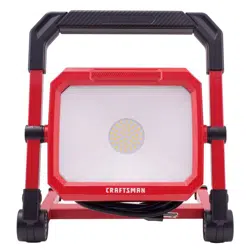Loading ...
Loading ...
Loading ...

9
E
6.
When the center LEDs light and you hear a constant beep, the stud sensor
has found the center of a stud (Figure
D
3
).
• STOP moving the stud sensor and continue to hold it at the current
position.
• STOP pressing .
7.
Press (Figure
A
6
) to mark the current position on the wall as the
center of the stud.
8.
To find another stud on the wall, repeat the same steps.
Finding Metal Objects
The stud sensor will let you know if a metal object (e.g., a pipe) is located
behind the wall within 3” (76.2mm) of the stud sensor. In metal detection
mode, the arrows do not indicate which direction to move the stud sensor
to find metal.
1.
To hold the stud sensor, place your thumb on one side of the stud sensor,
your pointer finger and your palm over the center of the stud sensor, and
the rest of your fingers on the same hand on the other side of the stud
sensor (Figure
C
1
).
2.
Position the stud sensor flat against the wall and parallel to a door or
window on the same wall, which gives you an indication of how the studs
are positioned behind the wall (Figure
C
2
).
3.
Without moving the stud sensor, use your pointer finger to press and hold
(Figure
A
2
). After 1 sec all the LEDs (except the Power LED)
will turn off.
4.
While still pressing , SLOWLY move the stud sensor to the left or the
right on the wall.
5.
As you move the stud sensor, watch the stud sensor LEDs.
• When and light on the left and right sides of the stud
sensor, slowly move the stud sensor to the left or right to find the metal
object (Figure
F
1
).
• When and light on the left and right sides of the stud sensor,
you will know that you are moving the stud sensor closer to the metal
object (Figure
F
2
).
6.
When the center LEDs (Figure
A
4
) light and you hear a constant beep,
the stud sensor has found a metal object (Figure
F
3
).
• STOP moving the stud sensor and continue to hold it at the current
position.
• STOP pressing .
7.
Press (Figure
A
6
) to mark the current position on the wall.
8.
To find another metal object behind the wall, repeat the same steps.
Maintenance
• When the stud sensor is not in use, clean the exterior parts with adamp
cloth, wipe the stud sensor with asoft dry cloth to make sure it is dry.
• Although the stud sensor exterior is solvent resistant, NEVER use solvents to
clean the stud sensor.
• Store the stud sensor in a clean location at a temperature between -67˚F
(-55˚C) and 158˚F (70˚C).
Troubleshooting
The LED is Blinking
The battery power is low.
• Check the AAA batteries to make sure:
• Each battery is installed correctly, according to (+) and (–) listed inside
the battery compartment.
• The battery contacts are clean and free of rust or corrosion.
• The batteries are new, high-quality batteries to reduce the chance of
battery leakage.
• Make sure the AAA batteries are in proper working condition. If in doubt, try
installing new batteries.
The LED does not Turn On
If the power LED does not turn on, or the power LED turns on for 1 sec
and then turns off, there is no battery power.
• Install two new, high-quality, name-brand AAA batteries in the stud sensor.
• Make sure each battery is installed correctly, according to (+) and (–) listed
inside the battery compartment.
The Stud Sensor is not Finding Studs
• Make sure the batteries are working.
• Make sure you have placed the stud sensor on a wall made of drywall or
another common building material. The stud sensor will not work on walls
made of concrete, mortar, block, brick work, plaster, carpeting, foil- faced
materials, metallic surfaces, or ceramic tile.
• Make sure you have placed the stud sensor flat against the wall, the stud
sensor is in a vertical position (parallel to a door or window), and you are
pressing and holding (Figure
A
3
) as you move the stud sensor
SLOWLY against the wall.
• Make sure the wall is not too thick. The CMHT77623 stud sensor can be used
to detect wood studs on walls < 1” (25mm) thick or metal studs on walls <
1.5” (38mm) thick.
• Make sure the wall has a smooth surface.
• Make sure the temperature and relative humidity are within the
Specifications.
The Stud Sensor is not Finding Metal Objects
• Make sure the batteries are working.
• Make sure you have placed the stud sensor on a wall made of drywall or
another common building material. The stud sensor will not work on walls
made of concrete, mortar, block, brick work, plaster, carpeting, foil- faced
materials, metallic surfaces, or ceramic tile.
• Make sure you have placed the stud sensor flat against the wall, the stud
sensor is in a vertical position (parallel to a door or window), and you are
pressing and holding (Figure
A
3
) as you move the stud sensor
SLOWLY against the wall.
• Make sure the wall is not too thick. The CMHT77623 stud sensor can be used
to detect Non-Ferrous Metal (e.g., copper) on walls < 2” (51mm) thick or
Ferrous Metal (contains iron) on walls < 3” (76.2mm) thick.
• Make sure the wall has a smooth surface.
• Make sure the temperature and relative humidity are within the
Specifications.
Loading ...
Loading ...
Loading ...
